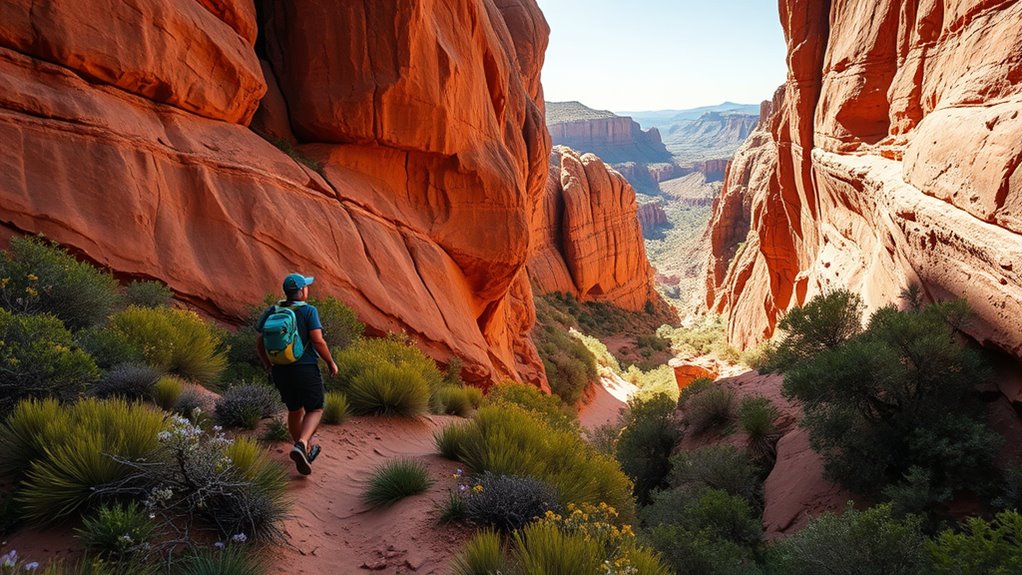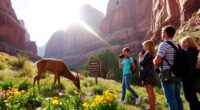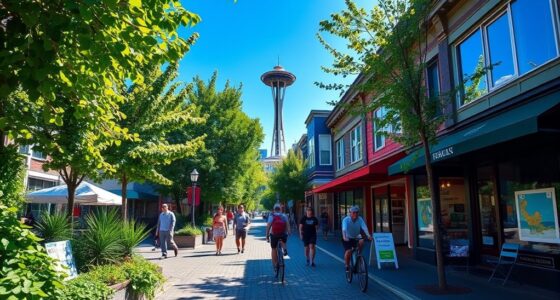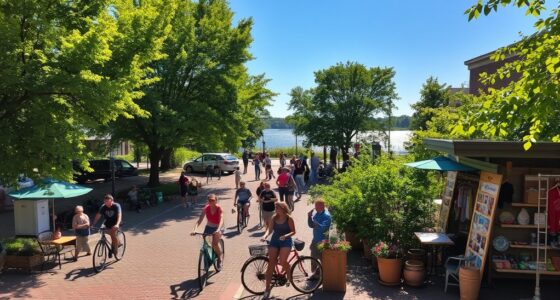Low-impact hiking in Zion National Park is vital for preserving its stunning landscapes and fragile ecosystems. By sticking to designated trails, you help protect native plants and wildlife, reduce soil erosion, and maintain the park’s natural beauty. Observing local flora and fauna mindfully enhances your outdoor experience, while practicing Leave No Trace principles guarantees minimal impact. By embracing these sustainable practices, you contribute to the long-term health of the environment. There’s much more to discover!
Key Takeaways
- Stick to designated trails to protect native flora and fauna and reduce soil erosion in Zion National Park.
- Observe wildlife from a distance and avoid feeding them to maintain their natural behaviors and health.
- Follow Leave No Trace principles by packing out all trash and minimizing your environmental impact.
- Engage in mindful observation of the park’s ecosystems to foster appreciation and enhance your hiking experience.
- Share sustainable hiking practices with others to promote community conservation efforts in Zion National Park.
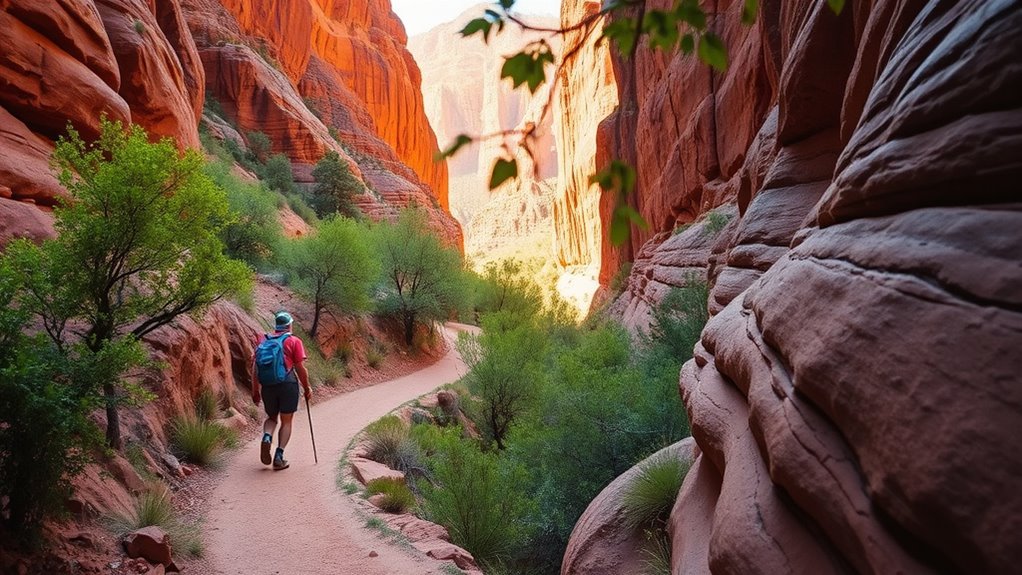
When you set out on a low-impact hike in Zion National Park, you’re not just enjoying breathtaking views; you’re also preserving the stunning landscape for future generations. Low-impact hiking means you take extra care when traversing the trails, ensuring you leave no trace behind. As you navigate the rugged paths, you’ll find that this approach allows you to connect more deeply with the environment, fostering a greater appreciation for the native flora and fauna that call this park home.
By sticking to designated trails, you help protect the delicate ecosystems that thrive in Zion. The park is rich with native flora, ranging from towering cottonwoods to vibrant wildflowers. Each step you take on established pathways minimizes your disturbance to these plants, allowing them to flourish. As you hike, pause to observe the intricate details of the landscape—notice how the sunlight filters through the leaves and illuminates the vibrant colors of the wildflowers. This mindfulness enhances your experience, reminding you of the importance of preserving these natural wonders.
Wildlife observation is another rewarding aspect of low-impact hiking. While you traverse the trails, keep your eyes peeled for the diverse array of wildlife that inhabits the park. You might spot mule deer grazing peacefully or the elusive bighorn sheep scaling the rocky cliffs. Remember to maintain a respectful distance and never feed the animals; this keeps them safe and helps maintain their natural behaviors. By minimizing your impact, you contribute to a thriving habitat for these creatures, ensuring that future visitors can enjoy the same extraordinary experiences.
As you hike, be mindful of your actions—stick to the trails, pack out what you pack in, and embrace the principles of Leave No Trace. Your commitment to low-impact hiking not only enriches your experience but also plays a crucial role in conserving Zion’s natural beauty. Share your experiences with fellow hikers, encouraging them to adopt similar practices. Together, you can foster a community that values and protects this incredible landscape. Additionally, engaging in sustainable practices during your outdoor adventures can enhance your appreciation for nature.
In essence, low-impact hiking in Zion National Park is about more than just appreciating stunning views; it’s about engaging in a sustainable way of exploring the outdoors. By respecting the native flora and practicing responsible wildlife observation, you’re helping preserve this remarkable environment for generations to come. So lace up your hiking boots, take a deep inhale of invigorating air, and enjoy every moment in this natural paradise.
Frequently Asked Questions
What Gear Is Essential for Low-Impact Hiking in Zion?
For low-impact hiking, you’ll want lightweight footwear that provides comfort and support on varied terrain. Invest in eco-friendly gear, like a reusable water bottle and biodegradable soap, to minimize your environmental footprint. A good backpack made from sustainable materials is essential for carrying your supplies. Don’t forget to pack a lightweight rain jacket and sun protection to stay safe while enjoying the beautiful surroundings. You’ll be prepared for an amazing adventure!
Are Pets Allowed on Hiking Trails in Zion National Park?
Pets aren’t permitted on most trails in Zion National Park, so you’ll need to plan accordingly. Familiarize yourself with the park’s pet policies to avoid disappointment. Only a few areas allow pets, primarily on designated roads and campgrounds. Trail restrictions help protect the park’s wildlife and landscape, ensuring everyone enjoys the natural beauty. If you’re visiting, consider finding a pet-friendly place to stay nearby while you explore the park.
How Can I Stay Safe From Wildlife While Hiking?
To stay safe from wildlife while hiking, keep your distance and respect their space. Learn about wildlife behavior to anticipate their actions. Don’t leave food or trash behind, as this attracts animals. Make noise as you hike to avoid surprising them, especially around blind corners. If you encounter an animal, stay calm, back away slowly, and avoid direct eye contact. Always prioritize your safety and the well-being of the wildlife around you.
What Are the Best Times of Year for Low-Impact Hiking?
When’s the best time for low-impact hiking? Spring and fall are ideal, as they offer mild temperatures and stunning scenery. During these seasons, you’ll enjoy pleasant weather while avoiding the summer heat and trail crowding. Spring showcases blooming wildflowers, while fall dazzles with vibrant foliage. Just be aware of seasonal weather changes, and prepare accordingly. By choosing these times, you can experience nature’s beauty without the hustle and bustle of peak tourist seasons.
Are There Guided Low-Impact Hiking Tours Available in Zion?
Yes, there are guided tours available that focus on eco-friendly hikes in Zion. These tours allow you to explore the stunning landscapes while minimizing your impact on the environment. You’ll get to enjoy the scenery and learn about local flora and fauna from knowledgeable guides. Engaging in these guided experiences can enhance your appreciation of nature while ensuring you leave no trace behind. So, consider joining a tour for a memorable adventure!
Conclusion
Low-impact hiking in Zion National Park not only preserves the stunning landscape but also enhances your connection with nature. Imagine trekking the serene trails of the Riverside Walk, where each careful step minimizes your footprint. By choosing low-impact methods, you’re not just protecting the park for future generations; you’re fostering a deeper appreciation for its beauty. Remember, every small action counts—your mindful hiking can inspire others to follow suit and help maintain this breathtaking environment.

